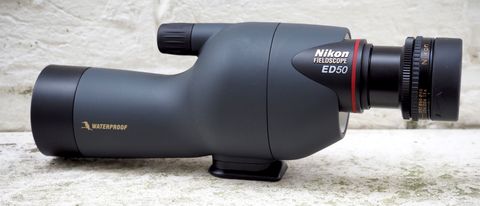Digital Camera World Verdict
Offering a really good balance between specification and size, the Nikon Fieldscope ED50 is a compact viewing device we’re more likely to take out and use than many competing brands’ physically larger scopes. In terms of handling and practicality, Nikon’s device feels like a ‘travel scope’, yet one without compromise – save for the fact we will need to buy the accessory of a separate eyepiece to actually use it straight out of the box. Buyer beware here: this eyepiece can potentially cost as much as the scope itself!
Pros
- +
Lightweight and compact
- +
Nitrogen-filled to prevent fogging
- +
Optical performance
Cons
- -
Comparatively small objective lens
- -
Eyepieces are generally extra...
- -
... and can be expensive!
Why you can trust Digital Camera World
The conveniently portable Nikon Fieldscope ED50 comes in a choice of either pearlescent green or charcoal grey livery, and in a straight or angled design – look for the model with the suffix ending in ‘A’ for that angled version. Since Nikon also makes cameras, it’s no surprise to learn that this device can also be used for the art of ‘digiscoping’ – namely attaching a camera so that images can be captured with the aid of the scope.
The ‘50’ in the model name refers to the size in diameter of the objective lens provided – 50mm, in this case. The ‘ED’ prefix unsurprisingly refers to Extra-low Dispersion glass to minimise chromatic aberration.
Be aware, though, that the Nikon Fieldscope ED50 is often sold without an eyepiece. These are interchangeable and sold separately. We used Nikon’s own 13-40x/20-60x/25-75x MC II Zoom Eyepiece, providing the ability to increase magnification on our particular device from between 13x and 40x. You do need to factor in the cost of the eyepiece with this device.
The ‘MC’ here denotes the use of multilayer coating. The only downside is that this particular eyepiece alone costs several hundred pounds/dollars, almost doubling the ‘base’ cost of the scope itself, so do take that into account if you’re considering a purchase of the Nikon Fieldscope ED50.
Specifications
Magnification: 13x to 40x using the provided eyepiece
Objective diameter: 50mm
Field of view at 1000m: 52 metres (at 13x)
Closest focusing distance: 3 metres
Eye relief: 14.1mm (at 13x)
Weight: 455g (eyepiece weighs an additional 150g)
Dimensions: 209mm in length, 71mm in width
Key features
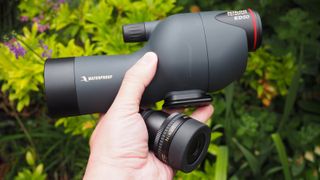
With a lot of choice in this field, Nikon here offers up a 50mm objective lens to which a 55mm filter can be attached, if so desired. It’s also optionally compatible with six of Nikon’s MC eyepieces and three wide DS eyepieces, which, as we mention above a potential purchaser will need to budget extra for.
On inspection of the core device, it happily ticks the boxes for the must-haves of a scope in its class, namely that there is a degree of weather proofing thanks to featuring a fog banishing nitrogen purged build and its claimed ability to survive being dunked a meter underwater for up to five minutes.
This has led its manufacturer to print that it is ‘waterproof’ on the barrel of the scope itself. Lens wise, this particular specimen features multi-layered coatings to ensure optimum light transmission, plus, ultimately, high-resolution viewing… more on which in due course.
Build and handling
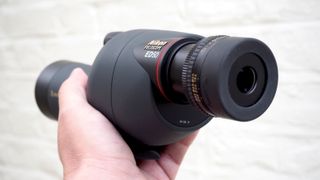
Though described as being relatively compact and lightweight for its class at just 455g, which means it can be use hand held rather than it being strictly necessary to always use it in conjunction with a tripod, this scope still manages to provide some solid heft. Particularly with optional yet essential eyepiece attached, ours weighing in at an extra, though barely noticeable, 150g. However, should we want to make use of the scope for longer periods, a tripod shoe is provided at the base of the unit, fitted with a standard screw thread.
With our right eye pressed against the eyepiece for viewing our subject, focus is adjusted via a prominent ridged dial half way down the barrel of the scope. This dial is sufficiently prominent that with our right hand adjusting magnification on the eyepiece itself, our left hand could readily find it to make focus adjustments ‘in the dark’ and on the fly, without our concentration deviating from the subject itself. So far, so intuitive.
Performance
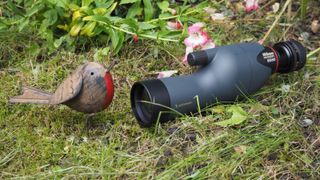
Not much bigger than the average pair of binoculars, in use this is one of the most practical scopes we’ve handled in recent weeks. Plus the compact size also means that we’re more likely to take the Nikon Fieldscope ED50 out and about with us. In short it’ll get more use.
While it is possible to use handheld, particularly if resting the eyepiece against your eye socket, or lens of your spectacles, for extra stability, at greater magnifications where it’s tricky to achieve a rock steady image without extra help, a tripod will indeed prove invaluable.
The Nikon eyepiece we were provided with, offering a magnification range between 13x and 40x when twinned with our 50mm objective lens, allowed us to adjust our view from one in which our avian quarry was centre of frame to one in which in which it was too big for the frame; so there is plenty of flexibility should you want to invest in an eyepiece that costs as much as the scope itself.
Verdict
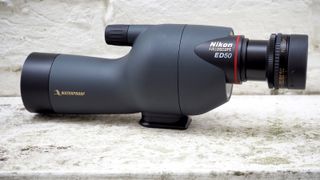
Lightweight, waterproofed and portable, yet not to any degree whereby quality, operability and results are unduly compromised, the Nikon Fieldscope ED50 is a good all rounder. We feel it is a lot more affordable and practical than rival offerings from Leica and Zeiss.
Here, however, we do have to budget extra for an eyepiece to be able to use it, with the premium option we were provided with costing nearly as much again as the original scope to which it is attached.
While you’d expect optical quality to not quite be a match for those industry leviathans we’ve just mentioned, in combination, it’s not actually that far off. In short, we were impressed, even if the combination of scope and eyepiece may cost you a few hundred more than you were initially expecting from the price of the scope alone.
Read more:
• Best spotting scopes
• Best binoculars
• Best monoculars
• Best opera glasses
• Best monopods
• Best travel tripods
Gavin has over 30 years’ experience of writing about photography and television. He is currently the editor of British Photographic Industry News, and previously served as editor of Which Digital Camera and deputy editor of Total Digital Photography.
He has also written for a wide range of publications including T3, BBC Focus, Empire, NME, Radio Times, MacWorld, Computer Active, What Digital Camera and the Rough Guide books.
With his wealth of knowledge, Gavin is well placed to recognize great camera deals and recommend the best products in Digital Camera World’s buying guides. He also writes on a number of specialist subjects including binoculars and monoculars, spotting scopes, microscopes, trail cameras, action cameras, body cameras, filters and cameras straps.
